service interval HONDA PASSPORT 2000 2.G Owners Manual
[x] Cancel search | Manufacturer: HONDA, Model Year: 2000, Model line: PASSPORT, Model: HONDA PASSPORT 2000 2.GPages: 267, PDF Size: 3.03 MB
Page 178 of 267
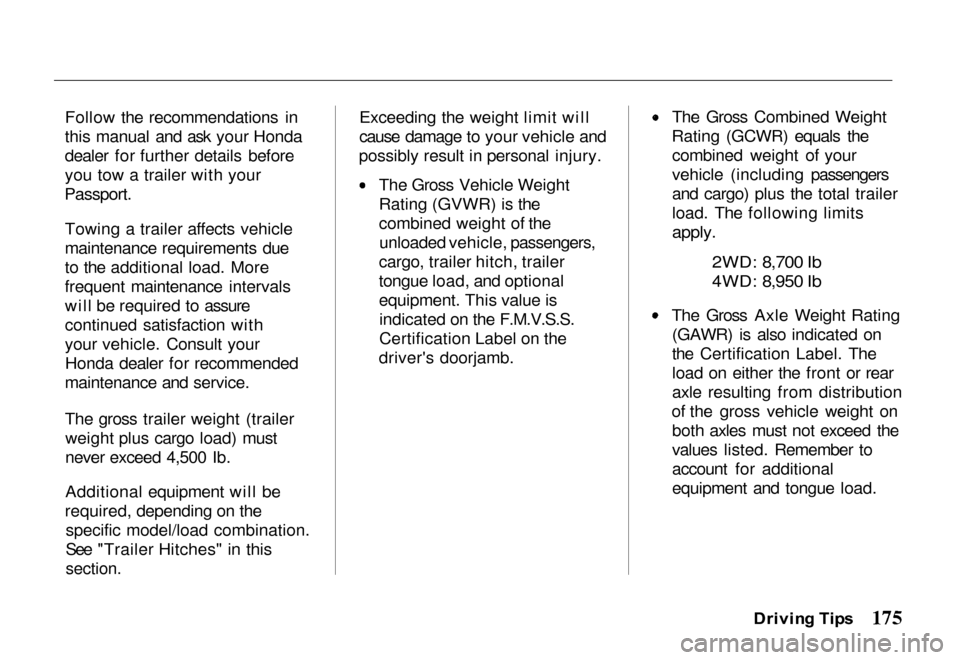
Follow the recommendations in
this manual and ask your Honda
dealer for further details before
you tow a trailer with your
Passport.
Towing a trailer affects vehicle
maintenance requirements due
to the additional load. More
frequent maintenance intervals
will be required to assure
continued satisfaction with
your vehicle. Consult yourHonda dealer for recommended
maintenance and service.
The gross trailer weight (trailer weight plus cargo load) must
never exceed 4,500 Ib.
Additional equipment will be
required, depending on the specific model/load combination.
See "Trailer Hitches" in this
section.
Exceeding the weight limit will
cause damage to your vehicle and
possibly result in personal injury. The Gross Vehicle Weight
Rating (GVWR) is the
combined weight of the
unloaded vehicle, passengers,
cargo, trailer hitch, trailer
tongue load, and optional
equipment. This value is indicated on the F.M.V.S.S.
Certification Label on the
driver's doorjamb. The Gross Combined Weight
Rating (GCWR) equals the combined weight of your
vehicle (including passengers
and cargo) plus the total trailer
load. The following limits
apply.
2WD: 8,700 Ib
4WD: 8,950 Ib
The Gross Axle Weight Rating
(GAWR) is also indicated on
the Certification Label. The
load on either the front or rear
axle resulting from distribution
of the gross vehicle weight on both axles must not exceed the
values listed. Remember to
account for additional
equipment and tongue load.
Driving Tip s
Page 194 of 267
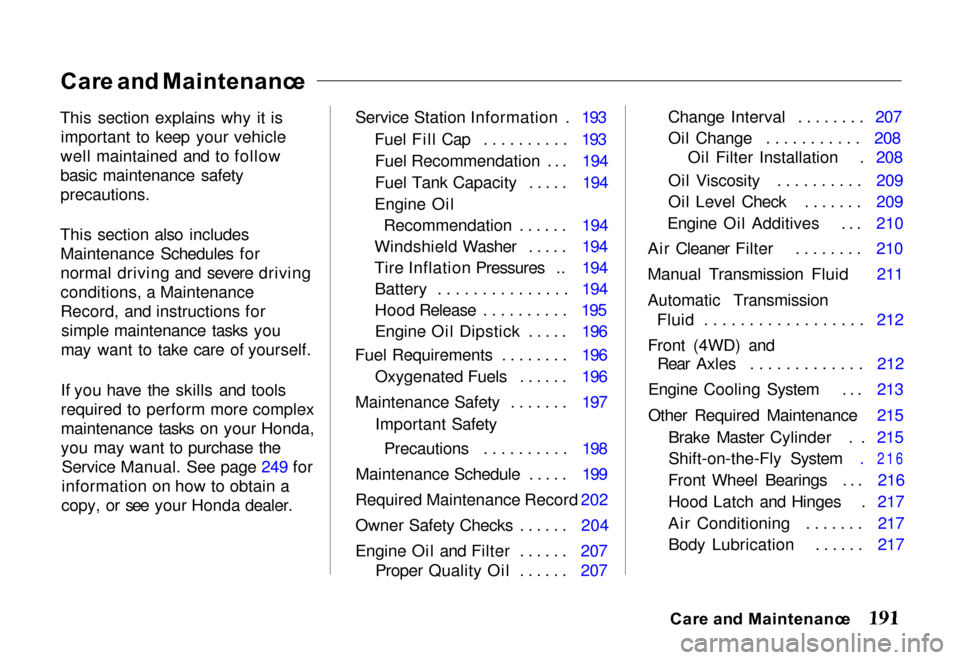
Car
e an d Maintenanc e
This section explains why it is important to keep your vehicle
well maintained and to follow
basic maintenance safety
precautions.
This section also includes Maintenance Schedules for
normal driving and severe driving
conditions, a Maintenance
Record, and instructions for simple maintenance tasks you
may want to take care of yourself.
If you have the skills and tools
required to perform more complex
maintenance tasks on your Honda,
you may want to purchase the Service Manual. See page 249 for
information on how to obtain a
copy, or see your Honda dealer. Service Station Information . 193
Fuel Fill Cap .......... 193Fuel Recommendation ... 194
Fuel Tank Capacity ..... 194
Engine Oil Recommendation ...... 194
Windshield Washer ..... 194
Tire Inflation Pressures .. 194 Battery ............... 194
Hood Release .......... 195
Engine Oil Dipstick ..... 196
Fuel Requirements ........ 196 Oxygenated Fuels ...... 196
Maintenance Safety ....... 197 Important Safety
Precautions .......... 198
Maintenance Schedule ..... 199
Required Maintenance Record 202
Owner Safety Checks ...... 204
Engine Oil and Filter ...... 207 Proper Quality Oil ...... 207 Change Interval ........ 207
Oil
Change ........... 208
Oil Filter Installation . 208
Oil Viscosity .......... 209
Oil Level Check ....... 209
Engine Oil Additives ... 210
Air Cleaner Filter ........ 210
Manual Transmission Fluid 211
Automatic Transmission Fluid .................. 212
Front (4WD) and Rear Axles ............. 212
Engine Cooling System ... 213
Other Required Maintenance 215 Brake Master Cylinder . . 215
Shift-on-the-Fly System
. 216
Front Whee
l Bearings ... 216
Hood Latch and Hinges . 217
Air Conditioning ....... 217 Body Lubrication ...... 217
Car e an d Maintenanc e
Page 202 of 267
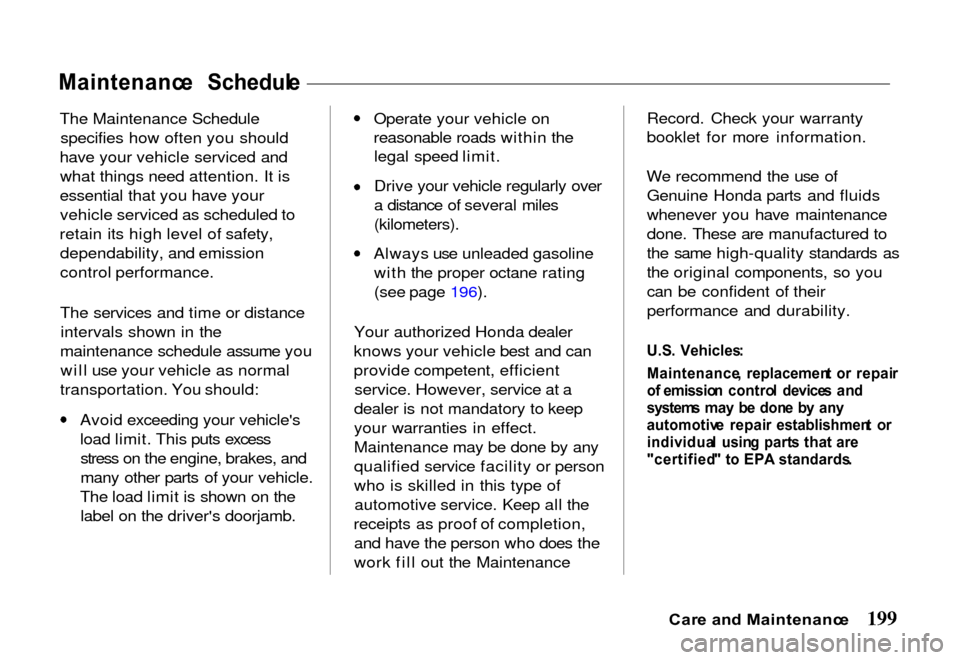
Maintenanc
e Schedul e
The Maintenance Schedule specifies how often you should
have your vehicle serviced and what things need attention. It is
essential that you have your vehicle serviced as scheduled to
retain its high level of safety, dependability, and emission
control performance.
The services and time or distanceintervals shown in the
maintenance schedule assume you will use your vehicle as normal
transportation. You should: Avoid exceeding your vehicle's
load limit. This puts excess
stress on the engine, brakes, and
many other parts of your vehicle.
The load limit is shown on the label on the driver's doorjamb. Operate your vehicle on
reasonable roads within the
legal speed limit. Drive your vehicle regularly over
a distance of several miles
(kilometers).
Always use unleaded gasoline
with the proper octane rating
(see page 196).
Your authorized Honda dealer
knows your vehicle best and can
provide competent, efficient service. However, service at a
dealer is not mandatory to keep
your warranties in effect.
Maintenance may be done by any
qualified service facility or person
who is skilled in this type of automotive service. Keep all the
receipts as proof of completion, and have the person who does the
work fill out the Maintenance Record. Check your warranty
booklet for more information.
We recommend the use of Genuine Honda parts and fluids
whenever you have maintenance
done. These are manufactured to
the same high-quality standards as
the original components, so you
can be confident of their
performance and durability.
U.S . Vehicles :
Maintenance , replacemen t o r repai r
o f emissio n contro l device s an d
system s ma y b e don e b y an y
automotiv e repai r establishmen t o r
individua l usin g part s tha t ar e
"certified " t o EP A standards .
Car e an d Maintenanc e
Page 212 of 267
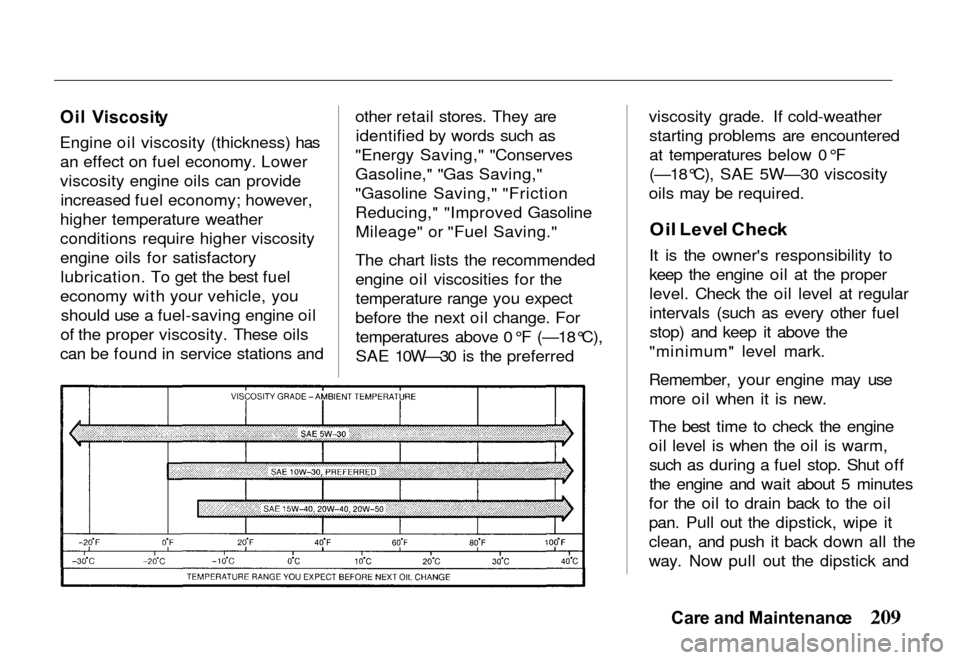
Oi
l Viscosit y
Engine oil viscosity (thickness) has an effect on fuel economy. Lower
viscosity engine oils can provideincreased fuel economy; however,
higher temperature weather
conditions require higher viscosity
engine oils for satisfactory lubrication. To get the best fuel
economy with your vehicle, you should use a fuel-saving engine oil
of the proper viscosity. These oils
can be found in service stations and other retail stores. They are
identified by words such as
"Energy Saving," "Conserves
Gasoline," "Gas Saving,"
"Gasoline Saving," "Friction
Reducing," "Improved Gasoline Mileage" or "Fuel Saving."
The chart lists the recommended
engine oil viscosities for the temperature range you expect
before the next oil change. For temperatures above 0°F (—18°C),
SAE 10W—30 is the preferred viscosity grade. If cold-weather
starting problems are encountered
at temperatures below 0°F
(—18°C), SAE 5W—30 viscosity
oils may be required.
Oi l Leve l Chec k
It is the owner's responsibility to
keep the engine oil at the proper
level. Check the oil level at regular
intervals (such as every other fuel stop) and keep it above the
"minimum" level mark.
Remember, your engine may use more oil when it is new.
The best time to check the engine
oil level is when the oil is warm, such as during a fuel stop. Shut off
the engine and wait about 5 minutes
for the oil to drain back to the oil
pan. Pull out the dipstick, wipe it
clean, and push it back down all the
way. Now pull out the dipstick and
Car e an d Maintenanc e
Page 217 of 267

You usually do not need to remove
the radiator cap to check the engine
coolant level.
Addin g Engin e Coolan t
To add engine coolant, remove the cap on the radiator reserve tank
and fill the tank up to the
maximum level mark. Add a
50/50 mixture of water and a good
quality ethylene glycol antifreeze. If you need to add engine coolant
frequently, see your Honda dealer
for a cooling system check.
If the proper quality antifreezeis used, there is no need to add
extra inhibitors or additives. They may be harmful to the proper
operation of the system.
Coolin g Syste m Servic e
The cooling system should be serviced at the intervals specified in the Maintenance Schedule as
follows:
Wash the radiator cap and filler
neck with clean water.
Check the engine coolant level
in the radiator and have it tested
for freeze protection. Add
ethylene glycol antifreeze, if
needed, to maintain freeze
protection at —33°F (—36°C).
Have the cooling system and
radiator cap tested for a pressure capacity of 15 psi (105
kPa). If a replacement cap is
needed, use a cap specified for
your model. Tighten all radiator and heater
hose clamps and inspect all
hoses. Replace the hoses if they
are swollen, "checked," or
otherwise worn. Carefully tighten the hose clamps at the
radiator. Overtightening could bend or collapse the radiator
fittings. Clean the front of the radiator
core and air conditioning
condenser.
It is the owner's responsibility to: Maintain the cooling system
freeze protection at —33°F
Car e an d Maintenanc e
Removing the radiator cap
while the engine is hot can
cause the coolant to spray out, seriously scalding you.
Always let the engine andradiator cool down beforeremoving the radiator cap.
Page 264 of 267
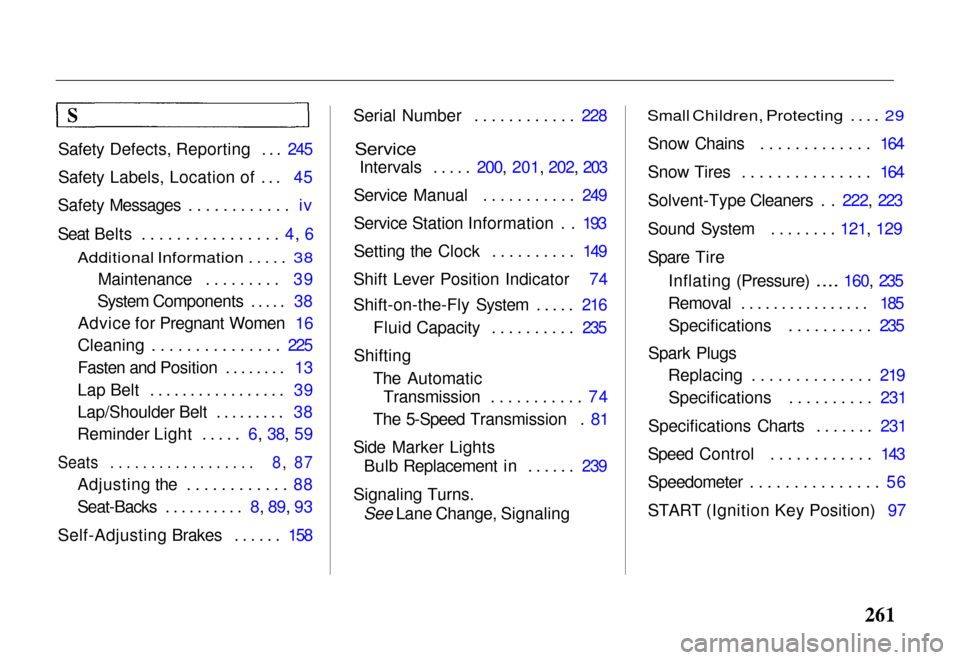
Safety Defects, Reporting ... 245
Safety Labels, Location of ... 45
Safety Messages ............ iv
Seat Belt
s ................ 4, 6
Additional Information ..... 38
Maintenance ......... 39
System Components ..... 38
Advice for Pregnant Women 16
Cleaning ............... 225
Fasten and Position ........ 13
Lap Belt ................. 39
Lap/Shoulder Belt ......... 38
Reminder Light ..... 6, 38, 59
Seats .................. 8, 87
Adjusting the ............ 88
Seat-Backs .......... 8, 89, 93
Self-Adjusting Brakes ...... 158 Serial Number ............ 228
Service
Intervals ..... 200, 201, 202, 203
Service Manual ........... 249
Service Station Information . . 193
Setting the Clock .......... 149
Shift Lever Position Indicator 74
Shift-on-the-Fly System ..... 216 Fluid Capacity .......... 235
Shifting The AutomaticTransmission ........... 74
The 5-Speed Transmission . 81
Side Marker Lights Bulb Replacement in ...... 239
Signaling Turns. See Lane Change, Signaling
Small Children, Protecting .... 29
Snow Chains ............. 164
Snow Tires ............... 164
Solvent-Type Cleaners . .
222, 223
Sound System ........ 121, 129
Spare Tire Inflating (Pressure)
.... 160, 235
Removal ................ 185 Specifications .......... 235
Spark Plugs Replacing .............. 219
Specifications .......... 231
Specifications Charts ....... 231
Speed Control ............ 143
Speedometer ............... 56
START (Ignition Key Position) 97